- Read about Mudras, four types of Abhinaya and the deeper meaning of ten single hand and ten double-hand hastas along with corresponding pictures.
Indian classical dances reflect India's rich cultural heritage. It is a complex art form that is unique in several ways and a fine combination of music, dance, sculpture, psychology, tradition, philosophy, history, histrionics, mathematics, body kinetics etc. Hence, classical dances have a distinct vocabulary of their own and it takes several years to master any particular classical dance.
Through the medium of varied movements, gestures, gesticulations, hasta mudras and music interwoven with "sahitya"; varied stories from Hindu traditions are narrated in the dance format in an attempt to reach out to the supreme, thereby establishing the relation between jeevatma (human soul)
and parmatma.
In other
words classical dance is not just a physical art of movements, it is the
expression of the soul. When a devoted dancer commences her performance,
with the offering of flowers at the lotus feet of the Lord, she surrenders
herself completely to the divine spirit, hence the performance rises from the
mundane to the spiritual level of consciousness, which is refreshing, rejuvenating
and an elevating experience not only for the dancer but for the audience as
well. (dancer could be she or he)
First what are Mudras?
According to Mudra expert Shri VK Bansal , “As per Eastern philosophies and culture and Yogic practices, 'Mudras' are systematic hand gestures. Literally, Mudra in Sanskrit means a posture/seal.”
“The fingertips of every living being have many concentrated nerve root endings which are free energy discharge points. Science also confirms that around every tip there is a concentration of free electrons. By touching together of the tips of the fingers or the finger tips to other parts of the palms this free energy (Prana) is redirected back into the body along specified channels, back up to the brain. The redirected energy traveling through the nerves stimulates the various chakras.” Source
Four Types of Abhinaya
As
mentioned in Natya Shastra and Abhinaya
Darpanam, there are four types of Abhinaya, namely Aharya, Angika, Vachika and Sattvika.
Aharya Abhinaya pertains to the make-up, costume, hair style and overall presentation of the dancer, which changes and differs, according to the style represented and character enacted. In the case of solo performances, the dancer appears in the normal costume and interprets the scene and characters through varied movements, gestures, and expressional dancing.
In dance dramas or plays, the attire or costume is differentiated completely according to the character represented, for instance if the actor or dancer has to enact the role of Hanuman, he or she should look like Hanuman. Hence the costume is made accordingly, with the attachment of the long tail etc.
In
Kathakali the make-up of the actor is a long drawn process of three hours
wherein the particular make up and costume is attired according to the
character represented and they do not change the make-up or costume during the
performance as they have to stick to the particular role represented. In plays
there are actors who enact different roles, hence have to change the costume in
split seconds.
Here I would like to narrate my personal experience, while enacting two different roles in the same production. In GD Madgulkar's Geet Ramayana known as Kathahi Rama Jankichi (Marathi),
directed by the late master performer Sachin Shanker, I was the sutradhar (story-teller) and Raja Janak
too. At the start of the presentation I appeared as the Sutradhar and after
some time I appeared as Raja Janak. Hence I had to change costume within a few
seconds. In one programme, the nada
of the pyjama completely came off and I was perplexed how I could wear the
pyjama without the nada but it struck me that I should tie the nada around the
pyjama for perfect fitting and that is what I did.
Note that Aharya abhinaya forms an integral part of classical dancing. Half the battle is won if you already
look like the character represented.
Angika abhinaya pertains to the body language of the dancer according to the character, animal or bird represented. The enactment of animals or birds is not easy to represent. I still remember when a foreigner enacted the angika abhinaya of Garuda brilliantly (the typical movement of flapping of the wings and the body moving simultaneously was unforgettable). Similarly, the Mysore based Bharata Natyam exponent Dr Vasundhara Doraiswamy had demonstrated the movements of peacock, the vahana
(vehicle) of Lord Kartikeya, immaculately.
Vachika abhinaya pertains to the speech and tone modulation of the actors. The tone or the style of speech changes according to the mood and character enacted. Classical dances are normally devoid of vachika abhinaya unless the need arises in a dance drama. Actually, the use of hasta mudras, gestures and gesticulations are sufficient to interpret the episode of the story.
Sattvika abhinaya pertains to elevating the performance to the spiritual level hence it is the personification of divinity. The sattvik quality is unique, a dancer attains the position after several years of devotion. One of the best known dancers and a pioneer performer Balasaraswati’s performance in the rendering of Krishna Nee Begane Baro is noteworthy for its sattvika quality.
In order to make classical dance more accessible, appreciative and enjoyable to most people I am listing below select hasta mudras (hand gestures) based on Bharata muni's Natya Shastra and Nandikesvaroa's Abhinaya Darpana, as illustrated in the book Dancing Is Fun by accomplished Odissi exponent Leesa Mohanty (who heads her dance academy in Mumbai known as Nirguna). There are 23 double hand gestures (Samyukta hastas) and 28 single hand gestures (asamyukta hastas). I have selected 20 hastas, 10 of single hand mudras and 10
of double hand mudras.
Single Hand Hastas known as Asamyukta hastas
1 Pataka is the first single hand gesture when the fingers are clasped together in an upright position with the thumb bent. Pataka is used in several ways. It can be used as a blessing if raised up or can be used to greet or show the way of going ahead or coming closer. It is also known as abhaya hasta and visible in statue of Lord Shiva, Lord Ganesha or the Goddess, projecting protection or blessing. Hence abhaya means “Do not fear, when I am there with you always.”
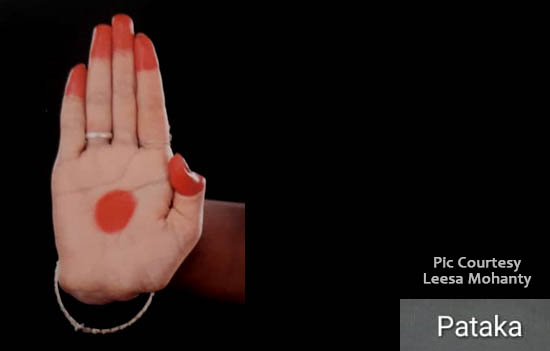
2 Kartarimukha in which the hand assumes the position of the face of a cutting instrument when the index singer and the little one are stretched out to form Kartarimukha. Kartari is symbolic of scissors. Hence, it is used to the difference, separation of a couple, death or signify the eyes.

3 Mayura as the name suggests is the peacock. It is also used to symbolise the peacock feather and when placed on the top of the head represents Sri Krishna. When placed sideways it demonstrates the typical gait or
dance of the peacock.
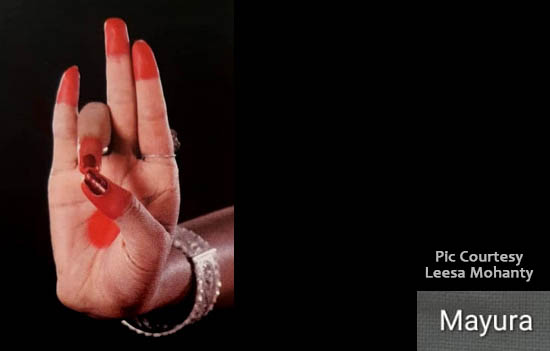
4 Sikhara symbolises the Lord or king. It can be used as holding the bow in the in the case of Lord Rama, determination or if placed little downwards can be used to question as well. When Sikhara is placed on Pataka it symbolises Shiva Linga.![]()
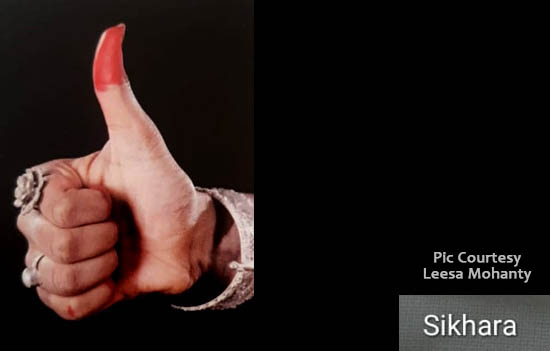
5 Kapittha forms the beak of a bird and if the index finger moves a little, you get the feeling as if the bird is opening its beak. It symbolizes goddess Lakshmi or Saraswati, can be used holding the dorner of cloth or worshipping god with incense and lamp.
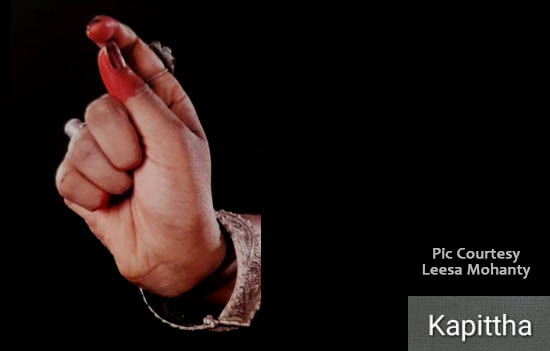
6 Katakamukha is used to denote plucking or flowers or holding
a garland, giving betel or requesting or asking for attention.
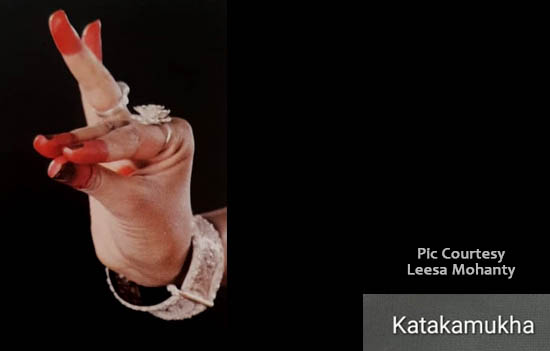
7 Suchi is to denote or point out any particular person or sound. It can also mean number one or absolute or the Sun.
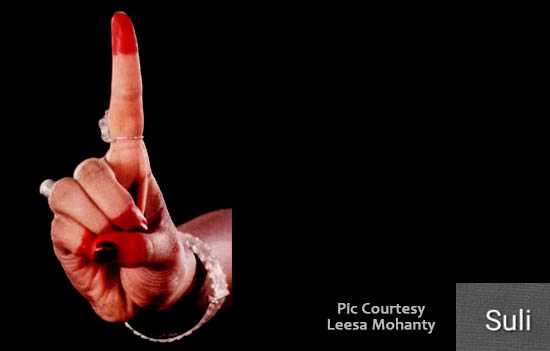
8 Mrigasira means head of a deer or the deer. Also used when in angika abhinaya; you have to show the gait or the movement of the deer and can be used to show movements or to call someone.
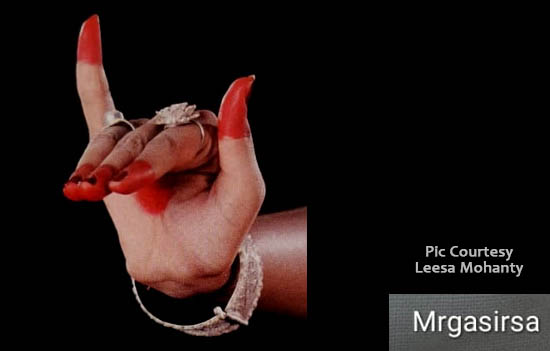
9 Simhamukha signifies the face of the lion. It could also denote cooking medicine of the physician or purifying.
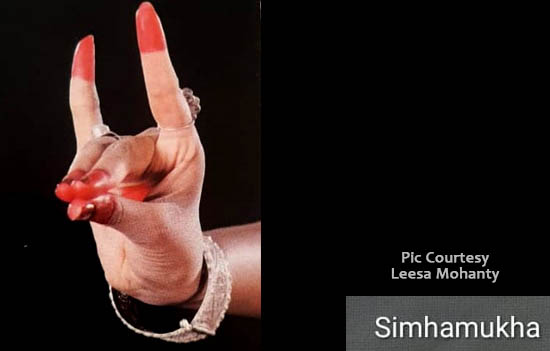
10 Trisula is the trident of Lord Shiva, hence used to signify the Lord. It is also used as a weapon to destroy evil i.e. the asuras.
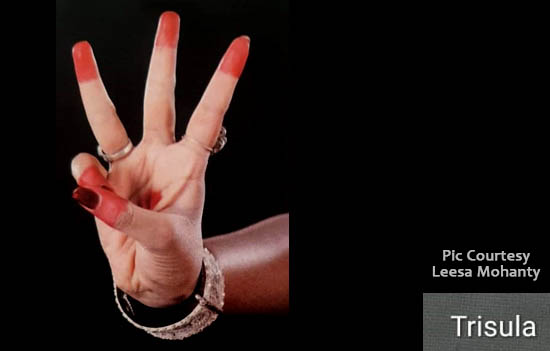
Double hand hastas known as Samyukta Hastas
1 Anjali if formed when both the hands are joined together, is used to greet or to pray or welcome anybody, popularly known as namaste or namaskaram.
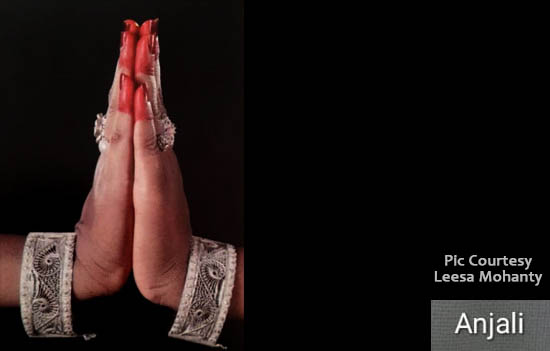
2 Karkata means the crab or used to signify multitude of people blowing the conch or lifting up the branches of the tree.

3 Katakavardharana is used in the worship of deities during a ceremony or during marriages too.
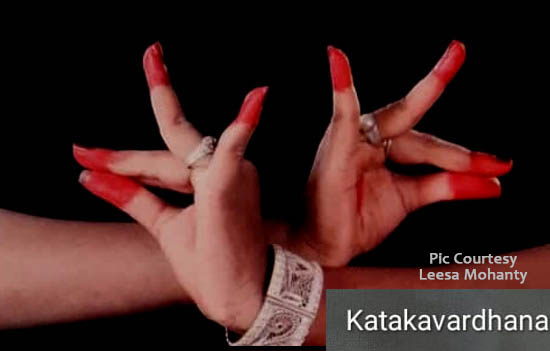
4 Sankha signifies the conch. The sound of the conch is considered most auspicious and used before the commencement of any particular function, social or religious. It is also symbolic of Lord Vishnu.
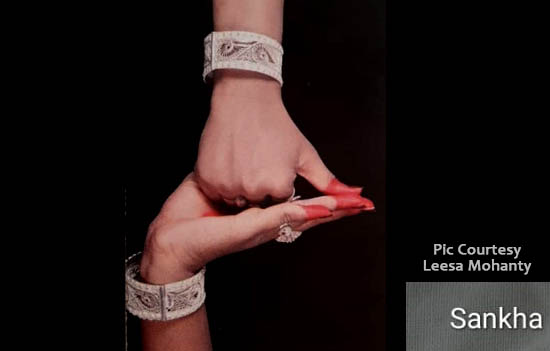
5 Pasa is used to denote enmity, difference of opinion or separation.
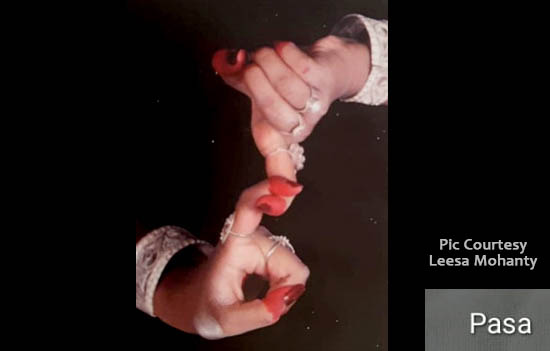
6 Matsya as the name suggests signifies fish and particular movements of the thumb show the typical movement of fishes. This is also used to interpret the Matsya avatara of Lord Vishnu.
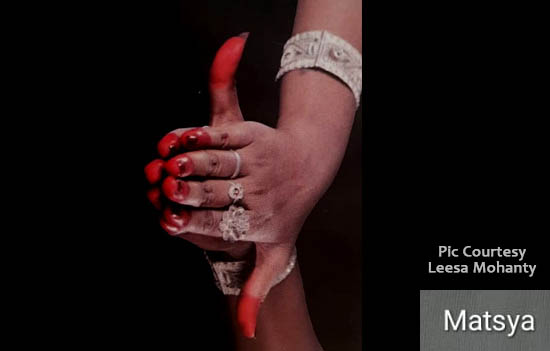
7 Chakra is another symbol of Lord Vishnu. Significantly known as the Sudarshan Chakra forms an integral part of the trinity of Indian classical dance.
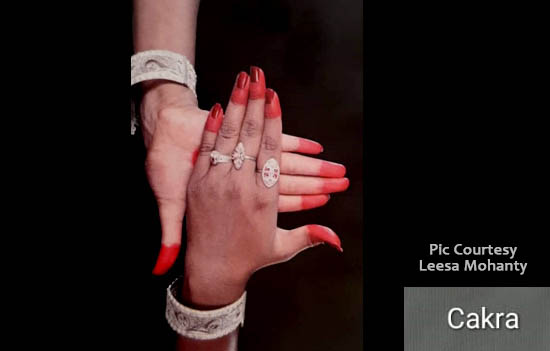
8 Kurma means tortoise, hence signifies the Kurma avatara of Lord
Vishnu.
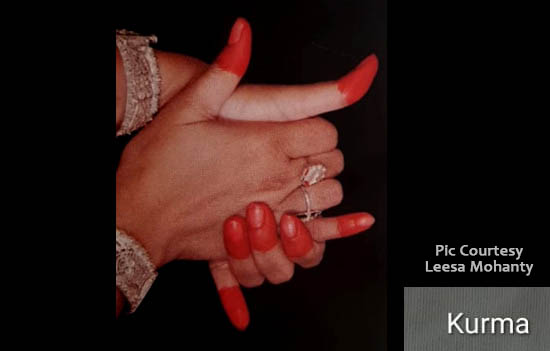
9 Varaha means the boar, hence
signifies the Varaha avatara of Lord Vishnu.
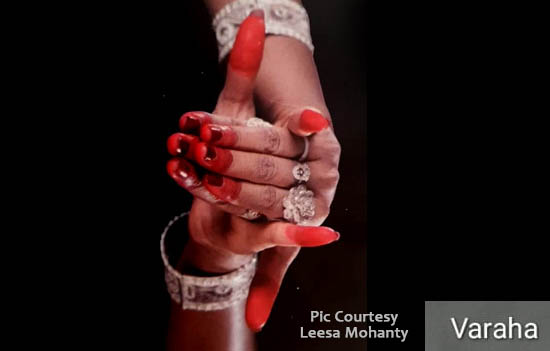
10 Siva Linga is used to show the Siva Linga of Lord Shiva. It also signifies
union of both purusha (masculine) and prakriti (feminine spirit).
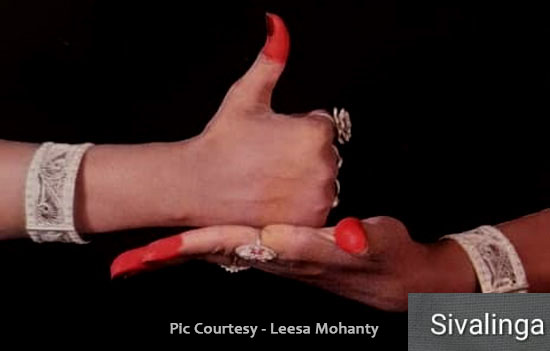
To conclude, I narrate an interesting incident when the veteran Kuchipudi exponent Dr Yamini Krishnamurti was rendering the popular number Swami Ra Ra, in a programme in New Delhi, with her large expressive eyes calling her Lord with amazing Netra
abhinaya. A Sardarji in the audience got carried away by the performance and walked towards the stage and Yamini immediately said, “I am calling my Swami, you are not my Swami.” It was a hilarious experience for the audience.
Guru Vijay Shanker is a professional Kuchipudi, Kathakali exponent, dance teacher, choreographer, actor and arts critic for over four decades, contributing for national and international publications. He is particularly credited for his lecture-demonstrations on Indian classical dancing which is a fine combination of both education and entertainment.
All pictures are courtesy and copyright Odissi exponent Leesa
Mohanty
To read all articles on
Dance
Also read
1. Bharata’s Natya Sastra
2. Konarak
Dance Festival album
3. Khajuraho
Dance Festival album
4. Elephanta
Dance Festival album
5. About
Sitara Devi
6. Bharatnatyam
in Canada
7. An Ode to Abhinaya, Natya and Bhav – Khajuraho Dance Festival 2021